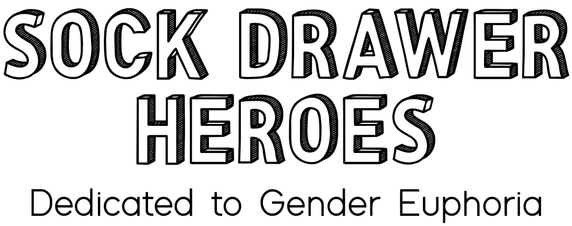Glossary
Assigned female at birth / Presumed female at birth (i.e. what gender the doctor presumed for someone at birth based on genitals).
Assigned male at birth / Presumed male at birth (i.e. what gender the doctor presumed for someone at birth based on genitals).
A term used for gender diverse people within some Aboriginal or Torres Strait Islander communities. Brotherboys are Indigenous people who were presumed female at birth but who have a male spirit. Brotherboys have distinct cultural identities and roles.
A term used to describe people who identify as the same gender that was presumed for them at birth.
The experience of distress or unease related to one’s gender. Dysphoria can be triggered in certain situations, such as if the wrong pronouns are used), or it can be a more internal experience, for example, some people experience dysphoria around their chest or genitals. The gender expression gear we sell at Sock Drawer Heroes helps alleviate dysphoria by allowing people to affirm their gender through their presentation.
Expressing one’s gender, typically through their external presentation. We refer to our collection of chest binders, tucking underwear, packers, etc. broadly as ‘gender expression products’ as these are products designed to help people affirm or express their gender. Having said that, you don’t have to identify as trans to use these items. Lots of people bind, pack and tuck for different reasons and all these reasons are valid!
Describes one's inner concept of their gender, such as man, woman or non-binary. One's gender identity may be different to what was presumed for them at birth, i.e. sex documented on their first birth certificate.
A term used to describe gender identities which sit outside of the binary identities of ‘male’ and ‘female’. Non-binary is a gender identity in itself, but there are other non-binary identities such as ‘genderfluid’, ‘gender non-conforming’ and ‘genderqueer’.
Words used to describe someone without using the person’s name, such as he/she/they. Some people use a single set of pronouns (e.g. she/her) while other people might use multiple pronouns interchangeably (e.g. he/him and they/them). Using someone’s correct pronouns is incredibly important. If you are not sure what someone’s pronouns are, just ask!
A term used for gender diverse people within some Aboriginal or Torres Strait Islander communities. Sistergirls are Indigenous people who were presumed male at birth but who have a female spirit. Sistergirls have distinct cultural identities and roles.
An acronym which means 'trans and gender diverse". This is an important inclusive term as not everybody who identifies as gender diverse also identifies as transgender.
A term used to describe people who identify as a different gender to what was presumed for them at birth.
A term to describe people who were presumed male at birth who identify with the female end of the spectrum, but who might not identify as ‘female’ or a ‘woman’. E.g. someone might identify as a ‘non-binary femme’ – i.e. identify as non-binary but sit somewhere towards the feminine end of the spectrum. You might notice we use the term ‘trans femme’ to describe our gender gear that is designed for trans women, such as tucking gaffs. This is to be inclusive of non-binary folk who identify with the feminine end of the spectrum but do not identify as female.
A term used to describe people who were presumed female at birth who identify with the male end of the spectrum, but who might not identify as ‘male’ or a ‘man’. E.g. someone might identify as ‘non-binary trans masc’ – i.e. identify as non-binary but sit somewhere towards the masculine end of the spectrum. You might notice we use the term ‘trans masc’ to describe our gender gear that is designed for AFAB trans guys, such as chest binders. This is to be inclusive of non-binary folk who identify with the masculine end of the spectrum but do not identify as male.
